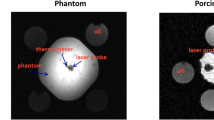Abstract
The purpose of this study is to compare the image quality of magnetic resonance (MR) treatment planning images and proton resonance frequency (PRF) shift thermography images and inform coil selection for MR-guided laser ablation of tumors in the head and neck region. Laser ablation was performed on an agar phantom and monitored via MR PRF shift thermography on a 3-T scanner, following acquisition of T1-weighted (T1W) planning images. PRF shift thermography images and T2-weighted (T2W) planning images were also performed in the neck region of five normal human volunteers. Signal-to-noise ratios (SNR) and temperature uncertainty were calculated and compared between scans acquired with the quadrature mode body integrated coil and a head and neck neurovascular coil. T1W planning images of the agar phantom produced SNRs of 4.0 and 12.2 for the quadrature mode body integrated coil and head and neck neurovascular coil, respectively. The SNR of the phantom MR thermography magnitude images obtained using the quadrature mode body integrated coil was 14.4 versus 59.6 using the head and neck coil. The average temperature uncertainty for MR thermography performed on the phantom with the quadrature mode body integrated coil was 1.1 versus 0.3 °C with the head and neck coil. T2W planning images of the neck in five human volunteers produced SNRs of 28.3 and 91.0 for the quadrature mode body integrated coil and head and neck coil, respectively. MR thermography magnitude images of the neck in the volunteers obtained using the quadrature mode body integrated coil had a signal-to-noise ratio of 8.3, while the SNR using the head and neck coil was 16.1. The average temperature uncertainty for MR thermography performed on the volunteers with the body coil was 2.5 versus 1.6 °C with the head and neck neurovascular coil. The quadrature mode body integrated coil provides inferior image quality for both basic treatment planning sequences and MR PRF shift thermography compared with a neurovascular coil, but may nevertheless be adequate for clinical purposes.



Similar content being viewed by others
References
Oto A et al (2013) MR imaging-guided focal laser ablation for prostate cancer: phase I trial. Radiology 267(3):932–940
Sercarz JA et al (2010) Outcomes of laser thermal therapy for recurrent head and neck cancer. Otolaryngol Head Neck Surg 142(3):344–350
Stafford RJ, Fuentes D, Elliott AA, Weinberg JS, Ahrar K (2010) Laser-induced thermal therapy for tumor ablation. Crit Rev Biomed Eng 38(1):79–100
Joo J, Sercarz JA, Paolini AA, Castro DJ, Paiva MB (2009) Laser-induced thermal therapy and cisplatin for recurrent head and neck cancer: a case characterized by an unusually long disease-free survival. Ear Nose Throat J 88(11):E13–E16
Banerjee C, Snelling B, Berger MH, Shah A, Ivan ME, Komotar RJ (2015) The role of magnetic resonance-guided laser ablation in neurooncology. Br J Neurosurg 29(2):192–196
Carpentier A et al (2011) Laser thermal therapy: real-time MRI-guided and computer-controlled procedures for metastatic brain tumors. Lasers Surg Med 43(10):943–950
Carpentier A et al (2008) Real-time magnetic resonance-guided laser thermal therapy for focal metastatic brain tumors. Neurosurgery 63(1 Suppl 1):ONS21–ONS28 discussion ONS28-9
Eckardt A, Barth EL, Kokemueller H, Wegener G (2004) Recurrent carcinoma of the head and neck: treatment strategies and survival analysis in a 20-year period. Oral Oncol 40(4):427–432
Pacella CM et al (2004) Thyroid tissue: US-guided percutaneous laser thermal ablation. Radiology 232(1):272–280
Shahrzad MK (2015) Laser thermal ablation of thyroid benign nodules. J Lasers Med Sci 6(4):151–156
Achille G, Zizzi S, Di Stasio E, Grammatica A, Grammatica L (2016) Ultrasound-guided percutaneous laser ablation in treating symptomatic solid benign thyroid nodules: our experience in 45 patients. Head Neck 38(5):677–682
Mack MG, Vogl TJ (2004) MR-guided ablation of head and neck tumors. Neuroimaging Clin N Am 14(4):853–859
Quesson B, de Zwart JA, Moonen CT (2000) Magnetic resonance temperature imaging for guidance of thermotherapy. J Magn Reson Imaging 12(4):525–533
Dietrich O, Raya JG, Reeder SB, Reiser MF, Schoenberg SO (2007) Measurement of signal-to-noise ratios in MR images: influence of multichannel coils, parallel imaging, and reconstruction filters. J Magn Reson Imaging 26(2):375–385
Lam MK, Huisman M, Nijenhuis RJ et al (2015) Quality of MR thermometry during palliative MR-guided high-intensity focused ultrasound (MR-HIFU) treatment of bone metastases. J Ther Ultrasound 3:5
Rieke V, Butts PK (2008) MR thermometry. J Magn Reson Imaging 27(2):376–390
Wlodarczyk W et al (1999) Comparison of four magnetic resonance methods for mapping small temperature changes. Phys Med Biol 44(2):607–624
Hayes CE, Axel L (1985) Noise performance of surface coils for magnetic resonance imaging at 1.5 T. Med Phys 12(5):604–607
Pruessmann KP, Weiger M, Scheidegger MB, Boesiger P (1999) SENSE: sensitivity encoding for fast MRI. Magn Reson Med 42(5):952–962
Henry RG, Fischbein NJ, Dillon WP, Vigneron DB, Nelson SJ (2001) High-sensitivity coil array for head and neck imaging: technical note. AJNR Am J Neuroradiol 22(10):1881–1886
Chung YC, Duerk JL, Shankaranarayanan A, Hampke M, Merkle EM, Lewin JS (1999) Temperature measurement using echo-shifted FLASH at low field for interventional MRI. J Magn Reson Imaging 10(1):108
Acknowledgments
We thank Amy Schneider (Medtronic, Minneapolis, MN, USA) for assistance in performing the laser ablation procedure.
Funding
Grant funding was used to pay for the phantom and MRI scan time.
Author information
Authors and Affiliations
Corresponding author
Ethics declarations
Conflict of interest
The authors declare that they have no conflict of interest.
Ethical approval
This work was approved by the IRB at our institution.
Grant support
This study was supported by Toshiba America Medical Systems/RSNA Research Seed Grant.
Rights and permissions
About this article
Cite this article
Ginat, D.T., Anthony, G.J., Christoforidis, G. et al. Comparison between whole-body and head and neck neurovascular coils for 3-T magnetic resonance proton resonance frequency shift thermography guidance in the head and neck region. Lasers Med Sci 33, 369–373 (2018). https://doi.org/10.1007/s10103-017-2397-1
Received:
Accepted:
Published:
Issue Date:
DOI: https://doi.org/10.1007/s10103-017-2397-1




